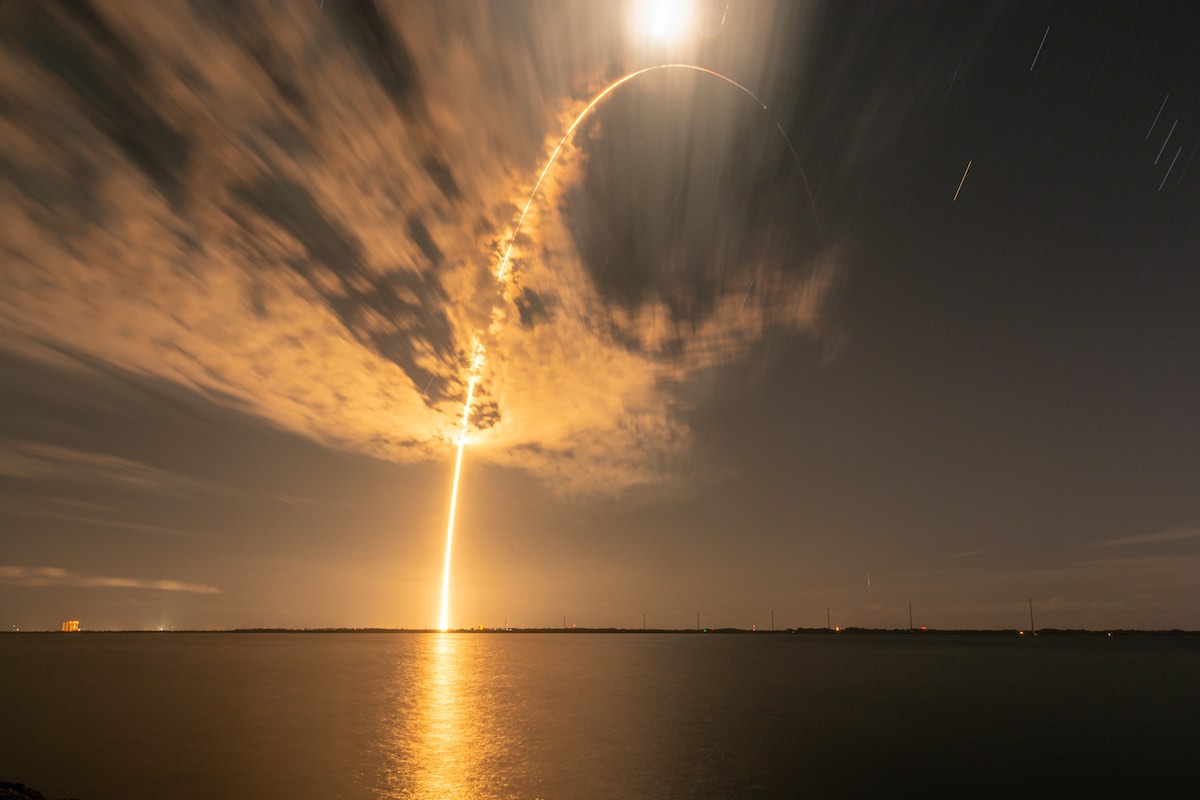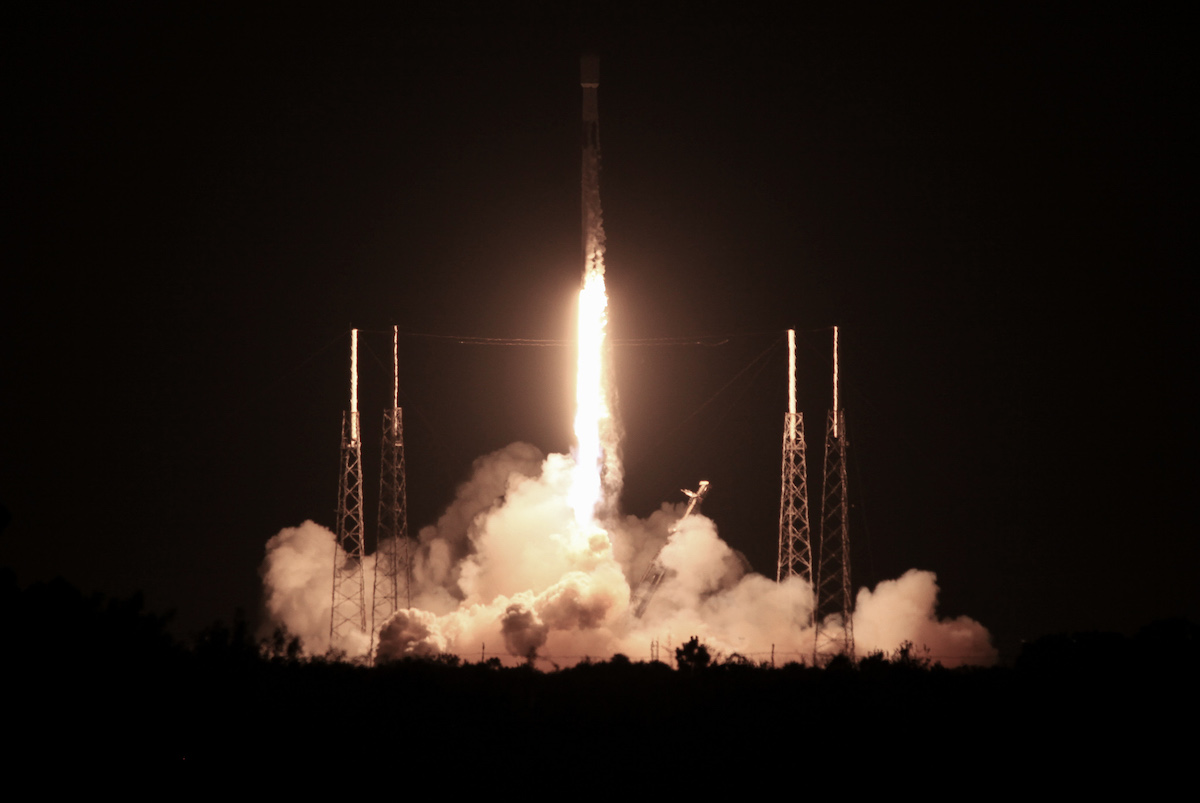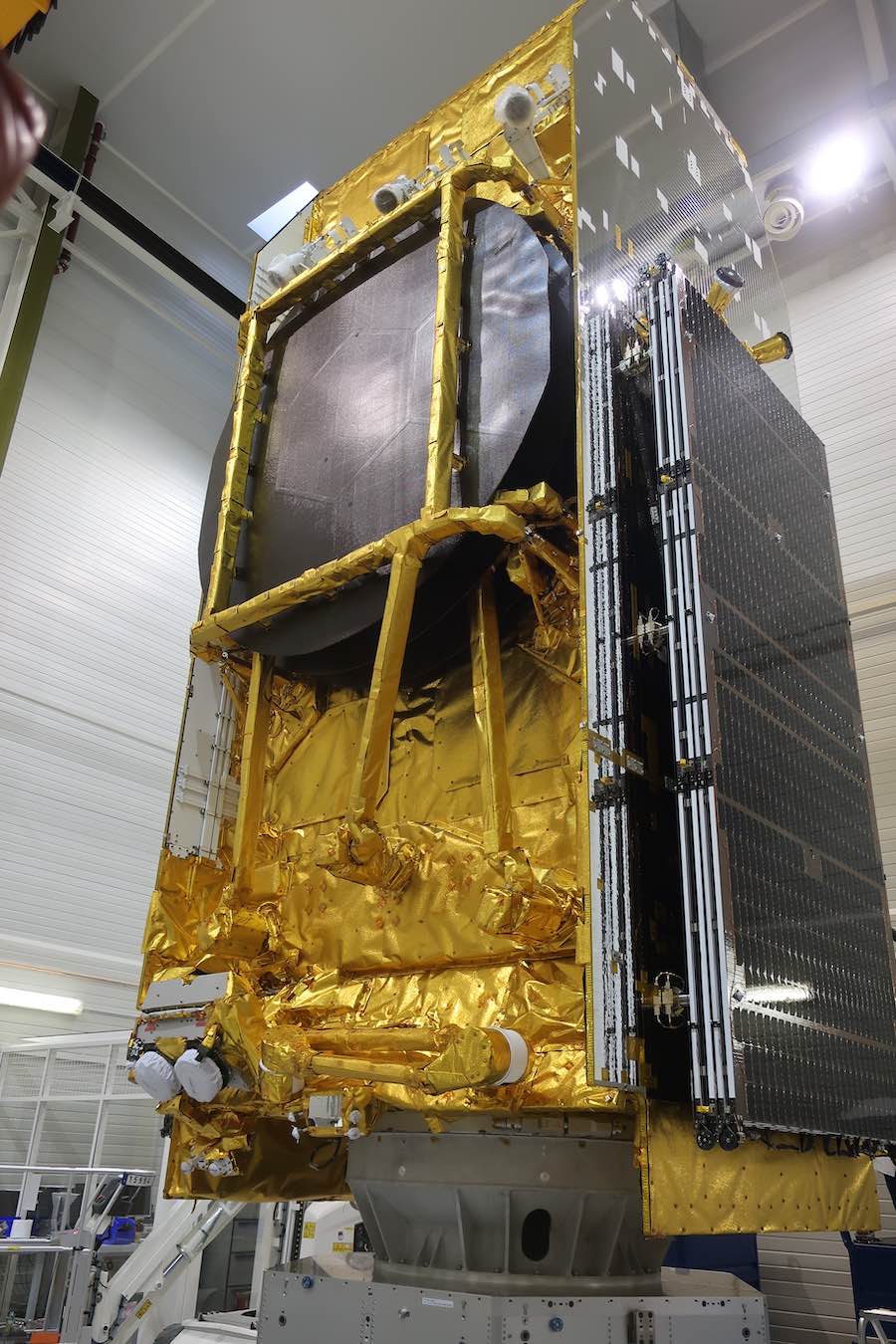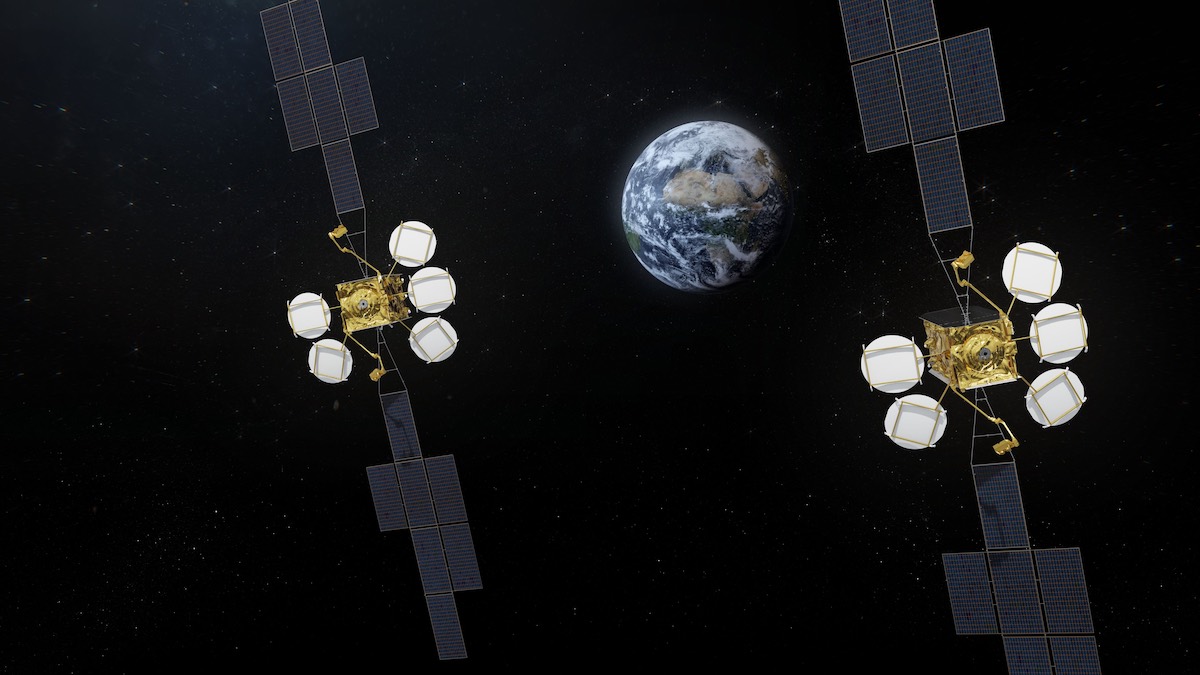
An Airbus-built communications satellite rocketed into orbit early Saturday from Cape Canaveral on top of a SpaceX Falcon 9 launcher, bound for a high-altitude perch in geostationary orbit to beam hundreds of TV and radio channels to Eutelsat customers across Europe, the Middle East, and North Africa.
SpaceX said it delayed the liftoff until the end of the night’s launch window at 1:22 a.m. EDT (0522 GMT) to allow additional time for data reviews, without providing any additional details.
With the data review complete, SpaceX’s launch team gave a “go” to load super-chilled, densified kerosene and liquid oxygen propellants into the Falcon 9 rocket. The launcher’s on-board computer took command of the countdown in the final minute, then gave the command to light nine Merlin 1D engines to propel the Falcon 9 off of pad 40 at Cape Canaveral Space Force Station.
Heading due east over the Atlantic Ocean, the 229-foot-tall (70-meter) Falcon 9 rocket darted through scattered clouds, trailing an orange flame from its engines as it surpassed the speed of sound. Two-and-a-half minutes after liftoff, the nine main engines cut off and the booster stage jettisoned from the Falcon 9’s upper stage. The second stage engine ignited to continue to climb into space with Eutelsat’s Hotbird 13F communications satellite.
The payload fairing shielding the Hotbird 13F spacecraft during the initial portion of the launch released in a clamshell-like fashion around three-and-a-half minutes into the mission. The two fairing halves descended under parachutes for recovery by a SpaceX boat downrange.
Liftoff of SpaceX’s Falcon 9 rocket from Cape Canaveral, boosting a new generation of European spacecraft technology into orbit with Eutelsat’s Hotbird 13F television broadcasting satellite. https://t.co/lwChvH8fxp pic.twitter.com/0z8A6oxcQO
— Spaceflight Now (@SpaceflightNow) October 15, 2022
The Falcon 9’s 15-story-tall first stage, meanwhile, extended titanium grid fins for aerodynamic stability and reignited three of its nine engines for a short braking maneuver during re-entry into the atmosphere. The rocket’s center engine then lit for a final landing burn before touchdown on SpaceX’s drone ship named “Just Read the Instructions” about 410 miles (660 kilometers) east of Cape Canaveral in the Atlantic.
The landing completed the booster’s third trip to space. The reusable first stage — designated B1069 in SpaceX’s rocket fleet — previously flew last December and in August.
The Falcon 9’s upper stage placed the Hotbird 13F satellite into a parking orbit, then reignited about 29 minutes after liftoff to accelerate to nearly 22,000 mph (35,000 kilometers per hour). About 36 minutes into the flight, the rocket deployed the spacecraft into an elliptical “super synchronous” transfer orbit ranging nearly 35,000 miles (about 56,000 kilometers) above Earth.
The launch marked the 181st flight of a Falcon 9 rocket, and SpaceX’s 100th launch from pad 40, the most-used of the company’s three launch facilities in Florida and California.
Eutelsat, a Paris-based commercial satellite operator, confirmed ground teams established contact with the new satellite, which completed its initial post-launch activation procedures early Saturday.

Hotbird 13F will unfurl solar panels and switch on its plasma propulsion system for several months of orbit-raising maneuver to reach a circular geostationary orbit more than 22,000 miles (nearly 36,000 kilometers) over the equator. The orbit-raising using electric propulsion takes longer than maneuvers relying on conventional rocket engines.
Hotbird 13F will orbit in lock-step with Earth’s rotation at 13 degrees east longitude.
By the middle of next year, Hotbird 13F should be ready to enter commercial service to start a 15-year mission broadcasting television programming to Eutelsat customers. Hotbird 13G, set for launch in November on another Falcon 9 rocket, will follow about a month after its twin satellite, heading for the same position in geostationary orbit.
“Hotbird 13F is the first of two satellites to be placed at the Eutelsat flagship 13 degrees east position, so this is an important event for us,” said Pascal Homsy, Eutelsat’s chief technical officer. “It will be the first satellite based on the electric propulsion Eurostar Neo platform by Airbus, fostering innovation and competitiveness in the European space industry.”
Falcon 9 has landed. SpaceX’s first stage booster — designated B1069 — has settled onto the deck of the drone ship “Just Read the Instructions” about 410 miles east of Cape Canaveral, covering that distance in less than 9 minutes. https://t.co/lwChvH8fxp pic.twitter.com/vOrSihr1Az
— Spaceflight Now (@SpaceflightNow) October 15, 2022
The Hotbird 13F satellite is built on the new Eurostar Neo spacecraft platform designed by Airbus Defense and Space, with funding support from the European Space Agency. The Eurostar Neo satellite design can accommodate additional payload capacity, and introduces more efficient power and thermal control systems than the previous generation of Eurostar E3000 Airbus-built satellites.
“It’s a huge new product, payload centric, more competitive than anything we have ever done,” said François Gaullier, head of telecommunications satellites at Airbus. “And we are more than happy to have developed this product, of which Hotbird 13F will be the first one to be launched.”
ESA provided about 130 million euros, or $126 million at current exchange rates, to help pay for development of the new satellite platform. Airbus funded the rest of the development cost with its own money under the umbrella of a public-private partnership.
Eutelsat was the first customer to sign up to use the new Eurostar Neo spacecraft platform. The launch of Eutelsat’s Hotbird 13F will be followed in November by the launch of a nearly identical satellite for Eutelsat named Hotbird 13G.
Hotbird 13F separation. Eutelsat’s new TV broadcasting satellite is flying free of SpaceX’s Falcon 9 launcher over the Indian Ocean. The Airbus-built satellite will unfurl solar arrays and use plasma engines to raise its orbit to geostationary altitude. https://t.co/lwChvHqoLx pic.twitter.com/t9EseBPV8D
— Spaceflight Now (@SpaceflightNow) October 15, 2022
“This Eurostar Neo satellite has been a partnership project done with Airbus, and with the first customer Eutelsat,” said Elodie Viau, ESA’s director of telecommunications and integrated applications. “This Eurostar Neo is a new set of satellites that are very competitive, that are optimized to be (cost) effective, and to use electrical propulsion in a very optimized way to allow more and more payload capacity.”
On its journey toward geostationary orbit, Hotbird 13F will use PPS5000 plasma orbit-raising thrusters developed by the French company Safran. The fuel-efficient plasma propulsion system relies on xenon gas and electricity to generate thrust, rather than a conventional liquid rocket fuel like hydrazine. That reduces the weight of the satellite, allowing engineers to launch on a smaller rocket or add additional payloads to support more communications capacity for customers.
So far, Airbus has sold eight satellites based on the new Eurostar Neo platform, including Hotbird 13F. Other customers for the Eurostar Neo satellite design include the UK Ministry of Defense, which signed a contract with Airbus to build a secure military communications satellite on the new spacecraft platform.
According to an Airbus spokesperson, Hotbird 13F weighed about 9,868 pounds (4,476 kilograms) at launch.

Thanks to improvements in satellite communications technology, Eutelsat will only need two new Hotbird satellites to replace the three aging Hotbird spacecraft operating at 13 degree east.
Homsy said the Hotbird fleet at 13 degrees east forms the highest capacity satellite broadcasting system covering the Europe, Middle East, and North Africa regions, delivering 1,000 TV channels to more than 160 million homes. Hotbird 13F and 13G will broadcast signals in Ku-band frequencies.
“We have something like over 600 pay TV channels, 300 free to air channels, 450 high definition TV, and 14 ultra high definition channels broadcast from this flagship 13 degrees east position,” Homsy said. “We are able also to provide 500 radio stations and multimedia services.”
Viau, head of ESA’s telecom directorate, said the space agency encourages its partners to launch their satellites on European rockets. Eutelsat, which owns the Hotbird 13F spacecraft, decided to launch the mission on a SpaceX rocket instead of with an Ariane launcher, based at the European-run spaceport in Kourou, French Guiana.
There are only three Ariane 5 rockets left to fly before retirement of that version of the Ariane launcher. And Europe’s new Ariane 6 rocket is not expected to debut until some time next year.

“There was just no possibility to take a seat on Ariane 5,” Homsy said. “We cannot delay the launch of this Hotbird and its brother in a month simply because they have to replace the three existing satellites which are already operating at 13 degrees east, which are going to come to an end of life by the time the two new satellites will come into service. So we had a very harsh deadline.
“We could not take any risks, and the only option that was finally available at hand was to launch from Florida,” Homsy said. “We would have loved to have launched from Kourou, but it was just not feasible.”
Email the author.
Follow Stephen Clark on Twitter: @StephenClark1.
